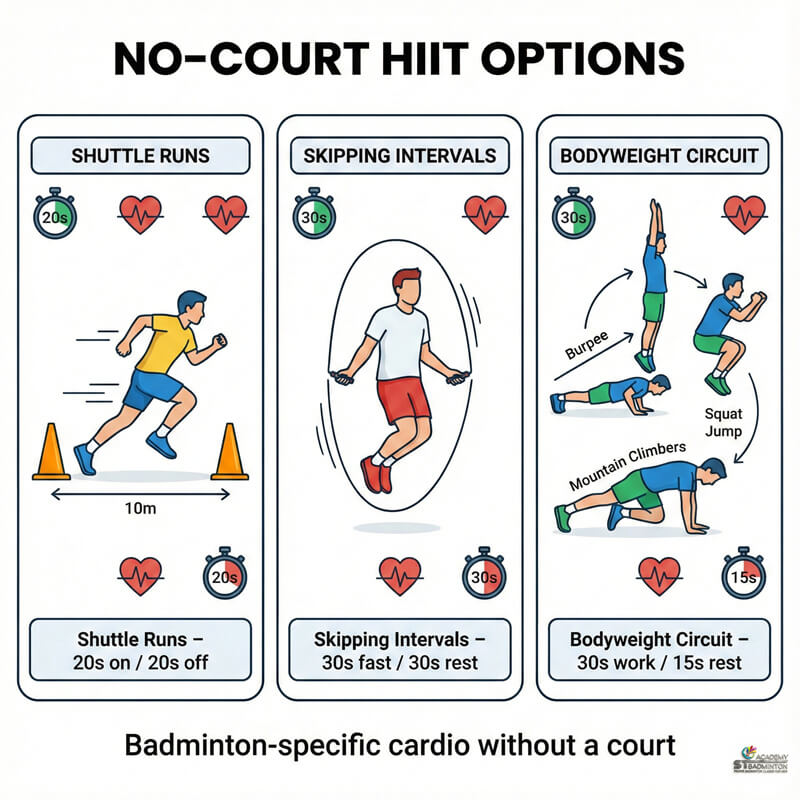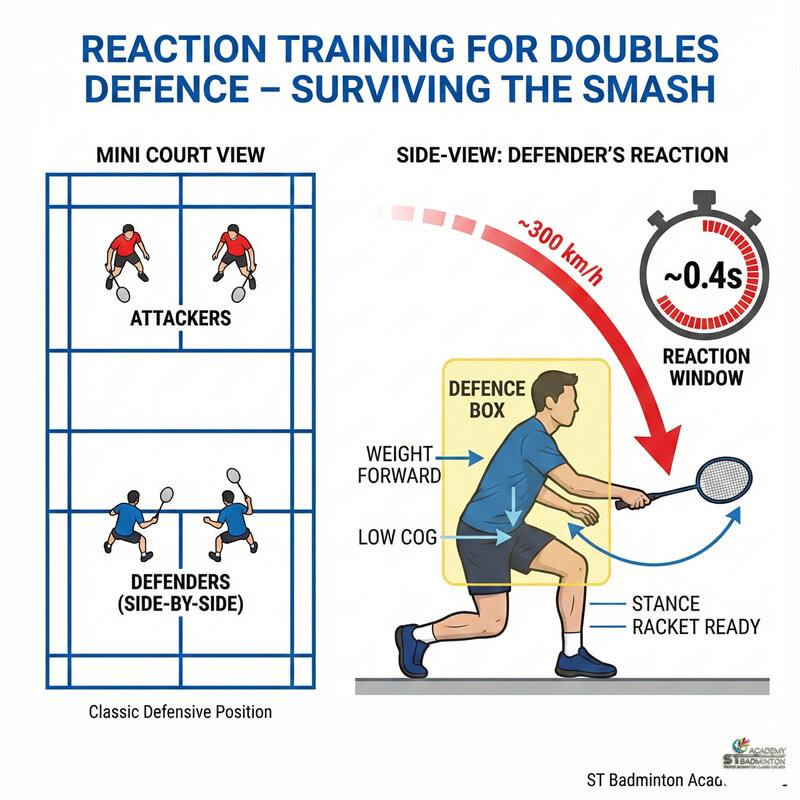Welcome to ST Badminton Academy’s badminton training in Malaysia! I’d like to share my top tips for preventing injuries in badminton training so that players of all levels can stay safe while having fun.
Whether you’re just starting out or are already an experienced player, staying aware of potential hazards and following these safety guidelines will help you avoid getting injured during your next badminton session. Read on to learn more about how to prevent injuries in badminton training!
Warm Up And Cool Down Properly
When it comes to preventing injuries in badminton training, warming up and cooling down properly are crucial. I always recommend that athletes limit the intensity of their warmup and cooldown activities so they can gradually increase or decrease their heart rate as needed. This helps prevent sudden changes in intensity which could lead to overstraining muscles and increased chances for injury.
It’s also important to practice drills regularly during a warm-up session before playing a match or participating in any other activity related to badminton. My advice is to focus on movements specific to badminton such as footwork and hand-eye coordination exercises while practicing these drills. This will help prepare your body for more intense movement, thus reducing the risk of injury later on.
By taking precautionary measures like limiting intensity, practicing drills, and using the right equipment you can keep yourself safe from harm when participating in badminton training sessions. It’s worth investing time into finding what works best for you since an ounce of prevention is worth a pound of cure!
Use The Right Equipment
I’m a badminton injury prevention specialist, and I’ve been playing the sport for many years. So let me share some top tips about using the right equipment to help you avoid injuries during training.
First of all, getting the proper grip is essential; make sure your racket is comfortable in your hand and that it fits snugly against your wrist. That way you can ensure maximum control over the shuttlecock when you play. Secondly, be sure to choose shoes with good cushioning and arch support – this will protect your feet from any jarring or sudden movement on court. Lastly, opt for clothing made with sweat-wicking materials so as not to restrict your movements while playing. Other than choosing a good racket and also remember to choose the best racket restring in Malaysia.
To sum up:
| Tips for Badminton Injury Prevention | Importance | Examples |
|---|---|---|
| Get the Proper Grip on Your Racket | Ensures maximum control and comfort | – Select a grip that fits snugly against your wrist |
| – Choose a racket that feels comfortable in your hand | ||
| Wear Appropriate Footwear | Provides cushioning and arch support | – Select shoes with good arch support and cushioning |
| – Protects feet from jarring and sudden movements on the court | ||
| Choose Breathable Clothing Material | Allows free movement and prevents restriction | – Opt for clothing made with sweat-wicking materials |
| – Ensures comfort and flexibility during play | ||
| Always Warm Up Before Practice | Prepares muscles and joints for intense activity | – Perform dynamic stretches and light exercises to increase blood flow |
| – Helps prevent injuries and improves overall performance | ||
| Listen to Your Body | Pay attention to signs of fatigue or discomfort | – Take breaks when needed and adjust the intensity of your training accordingly |
| – Consult with a healthcare professional if persistent pain or issues arise |
Listen To Your Body
When it comes to preventing injuries during badminton training, the most important thing is to listen attentively to your body. | Trust your instincts and be mindful of any uncomfortable sensations that arise during a session.
The first step in injury prevention is being aware of how you are feeling as you train. | If you feel pain or discomfort at any time, take a break immediately until the sensation subsides. It’s better to have a few moments away from the court than risk further damage by continuing with a movement that causes pain.
Prioritizing rest days and proper nutrition can also help reduce the chance of injury when training for badminton. | Eating healthy, balanced meals helps maintain energy levels while giving muscles what they need to stay strong and resilient during intense activity. Taking regular breaks between practice sessions allows your body adequate time to recover and repair itself before getting back on the court again.
By listening attentively and trusting your instincts when something doesn’t feel right, we can make sure our bodies remain safe even as we strive towards peak performance in our favorite sport. Knowing when to push ourselves and when to pull back will go a long way towards keeping us healthy and ready for action whenever we hit the court!
Maintain Proper Form
It’s no surprise that maintaining proper form is essential to preventing injuries in badminton training. According to a study conducted by the Journal of Physical Activity and Health, almost 40% of all sports-related injuries are due to bad technique or posture. Therefore, if players focus on honing their technique and strengthening their core muscles, they can significantly reduce the chances of getting injured while playing.
The first step towards attaining good technique is to focus on taking small steps and using your body weight when performing shots. This allows you to maintain balance during the entire shot without jarring your joints or muscles too much. Additionally, it helps keep your torso upright which keeps your movements fluid and smooth.
Furthermore, stretching regularly will help improve flexibility which makes executing complex shots easier as well as prevent muscle strain from awkward positions taken during play. Moreover, doing warm up exercises such as dynamic stretches before each session will also help loosen up tight muscles making them more resistant to injury should an incorrect movement be made during a match.
Another important element for avoiding injury is ensuring that one does not overtrain themselves as this could lead to fatigue which often causes poor technique resulting in strained limbs or pulled muscles leading to prolonged time away from badminton activity. Thus, it is crucial that players take regular breaks between sessions and allow enough rest so that their bodies remain healthy and ready for action! With these tips in mind, players can look forward to enjoying plenty of safe and enjoyable games!
Avoid Over-Training
As a badminton injury prevention specialist, I am often asked about the best ways to prevent injuries when training for badminton. One of the most important things is avoiding over-training. Overtraining can lead to exhaustion and potentially dangerous injuries that could take a long time to heal. To avoid this, proper pacing and strength training are essential elements of any successful badminton workout plan.
| Proper Pacing | Strength Training |
|---|---|
| Gradually increase intensity of workouts | Improve muscle endurance & flexibility by using weights or body resistance exercises |
| Don’t exceed 60 minutes per session | Utilize rest days between workouts to allow your muscles to properly recover |
| Vary up your routines with different drills & activities so you don’t get bored or burn out too quickly | Incorporate balance exercises into routine like squats, lunges, deadlifts etc. |
When it comes to preventing injuries while playing badminton, proper pacing and strength training should not be overlooked. Taking breaks in between sets during practice sessions helps keep your energy levels high throughout longer practices and tournaments, while also helping reduce fatigue which can ultimately cause strain on the body.
Additionally, engaging in regular strength training within one’s own exercise regime will help improve overall physical performance and build muscular endurance needed for intense activity such as badminton matches. With these tips in mind, athletes can train smarter and safer!
Having an effective regimen for avoiding over-training is key; however it is just as important for players to make sure they have proper footwork both on the court and off. This means ensuring that proper form is maintained during all movements whether running sprints or even doing jumping jacks in warm ups – having correct form prevents unnecessary stress on joints and muscles which makes them less prone to injury.
Use Proper Footwork
Now that we’ve discussed the importance of avoiding over-training, let’s dive into proper footwork for injury prevention in badminton training. Did you know that 90% of all sports injuries are a result of poor technique and improper movement? It is vital to learn proper footwork and pacing when playing badminton so as to reduce the risk of getting injured while on court.
Having the right form can help maintain balance and control. This means having your feet shoulder width apart with knees slightly bent, and then taking steps forward or back rather than leaping or jumping. Taking smaller steps also helps ensure that each part of your body moves together as one unit instead of moving separately which could lead to possible misalignments, twists and sprains in joints. Proper spacing between yourself and your opponent will give you more time to react, allowing you to better prepare for returns and shots.
It is essential to use good judgement when deciding how hard you should be pushing yourself during practice sessions. Start out at a slower pace until your muscles have warmed up, slowly increase speed once they feel ready. Pacing yourself properly does not only prevent injuries but also improves performance since it ensures that energy levels stay consistent throughout the game; conserving energy early allows for quick bursts late in sets if needed. Investing some time into learning basic fundamentals such as proper footwork can go a long way in helping protect from potential injuries down the line! To keep our bodies healthy while training, it is important to stay hydrated too…
Stay Hydrated
As a badminton injury prevention specialist, I cannot emphasize the importance of staying hydrated during training enough. It’s essential to drink water regularly and to make sure you get proper nutrition for optimal results. Not only does proper hydration help prevent injuries – it also helps athletes improve their performance and maintain focus on the court!
Here are some tips that can help:
| Tips for Physical Well-being during Training | Importance | Examples |
|---|---|---|
| Drink Water | Ensures proper hydration and minimizes the risk of dehydration | – Consume water before, during, and after training sessions |
| – Helps maintain overall body function and prevents cramping | ||
| Eat a Balanced Diet | Provides essential nutrients for sustained energy levels | – Include fruits and vegetables in your diet for vitamins and minerals |
| – Consume carbohydrates like whole wheat bread and pasta for extended workouts | ||
| Stay Away from Sugary Drinks & Caffeine | Prevents energy crashes and supports sustained performance | – Avoid sugary drinks and caffeinated beverages during training |
| – Opt for natural energy sources such as fresh fruit juices or smoothies with yogurt |
These tips focus on maintaining physical well-being during training, emphasizing the importance of proper hydration, a balanced diet, and avoiding sugary drinks and caffeine to sustain energy levels and overall performance.
Staying hydrated is an integral part of any athlete’s routine – so next time you hit the court make sure you have a full water bottle ready to go! To ensure maximum safety while playing badminton, it’s important to also get adequate rest between matches and practices too.
Get Adequate Rest
Making sure to get enough rest and stay hydrated are just two pieces of the injury prevention puzzle for those engaging in rigorous badminton training. To ensure your body is performing at its best, there are several other steps you must take before lacing up your shoes.
The following table summarizes the top tips for preventing injuries during a badminton session:
| Tips | Description |
|---|---|
| Stretch Regularly | Make sure to stretch all muscles groups prior to playing and continue stretching during breaks from play |
| Wear Supportive Shoes | Investing in proper footwear that provides arch support will help prevent ankle sprains & foot fatigue |
| Practice Proper Form | Executing strokes with correct technique can reduce risk of muscle strain or joint pain |
| Warm Up Adequately | Doing light cardiovascular activity such as jogging helps loosen ligaments, muscles and tendons prior to exercise |
| Listen To Your Body | If something does not feel right, stop immediately and seek medical attention if needed |
As a badminton injury prevention specialist, I would highly recommend taking these precautionary measures whenever participating in any physical activities. In addition to this list, it’s important to always warm-up properly before starting any exercises and cool down afterwards.
This will minimize soreness while improving overall performance. Taking care of yourself outside of the court is equally essential; make sure to eat nutritious foods, drink plenty of water throughout the day and prioritize adequate rest.
Frequently Asked Questions

How Often Should I Play Badminton During A Training Session?
It’s important to remember that when training for badminton, you want to avoid overdoing it. If you play too often during a session, your body can become fatigued and more prone to injury. I’d recommend playing no more than two or three times per week while focusing on stamina building exercises in between. Make sure to always warm up with drills before playing and cool down afterwards – this helps reduce the risk of straining muscles.
What Is The Best Way To Maintain Proper Form While Playing?
If you’re serious about badminton, you know that maintaining proper form is key for playing at your best and staying injury-free. To make sure you stay on the court and off the sidelines, it’s important to warm up with some drills before each game or training session to help build strength and flexibility in muscles used during play.
Additionally, good posture can go a long way in avoiding injuries – keep your feet shoulder width apart, knees bent slightly, back straight and eyes forward when hitting shots. Proper alignment of your body will enable you to better control how hard you hit the shuttlecock as well as reduce stress on joints caused by incorrect movements. With these few simple steps, you’ll be able to enjoy a safe badminton experience!
Are There Any Stretches I Should Do Before And After Playing?
When it comes to badminton training, proper stretching is one of the most important things you can do to prevent injuries. Before playing, I recommend doing a few dynamic stretches like arm circles and butt kicks to warm up your muscles and prepare them for play. After playing, static stretches such as forward folds are great for maintaining flexibility in your joints and preventing soreness.
When selecting equipment, make sure everything fits properly – especially shoes! If possible, have someone with knowledge about injury prevention help you choose the right size before purchasing any gear or accessories. All these steps will ensure that your body is well taken care of during badminton training.
Are There Any Particular Types Of Shoes That Are Best For Playing Badminton?
A good pair of badminton shoes can make a world of difference when playing the game. For example, my friend Joe recently switched from regular running shoes to badminton-specific shoes and he noticed an immediate improvement in his court movement and agility. Badminton-specific shoes are designed to provide extra stability and better grip on the court surfaces which helps prevent injuries while performing warm up drills or executing game strategies.
Additionally, they have more cushioning and arch support than traditional sneakers so your feet stay comfortable even during long matches. Investing in a quality pair of badminton shoes is essential for preventing injury and improving performance!
What Is The Most Effective Way To Avoid Over-Training?
The most effective way to avoid over-training is by following a balanced routine that includes both proper nutrition and adequate rest. Eating the right foods helps your body recover from intense training, while allowing for plenty of time to rest in between sessions gives muscles a chance to build up strength and reduce fatigue.
It’s also important not to push yourself too hard – listen to your body if something feels wrong or you’re feeling overly tired, as this could be an indication of possible injury. With these tips in mind, you can help ensure that you stay healthy and active during badminton practice!
Learn Professional Badminton Foundation for Safety Malaysia
Badminton training can be a great way to stay in shape and have some fun, but it’s important to do so safely. The best way to avoid injuries is to make sure you’re playing at the right intensity level for your fitness level, maintaining proper form while playing, stretching before and after each session, and wearing shoes appropriate for badminton.
Some people may argue that this all takes too much effort or time – and that’s understandable. But when you take into consideration how easily badminton-related injuries can occur if these precautions are not taken, it becomes clear that investing even a few minutes of extra preparation beforehand will pay off significantly in avoiding preventable harm down the line.





